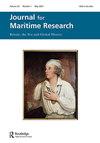Order and disorder in the British Navy, 1793–1815: control, resistance, flogging and hanging
Q3 Arts and Humanities
引用次数: 0
Abstract
interweaving of background information is sensitively done and, overall, adds value to the story, providing a broad perspective on Fanny’s life both as part of the lively Austen clan and as a member of a wider naval ‘family’. Of greatest interest to literary scholars is undoubtedly the link that Fanny may have provided between Austen and her fictional naval characters. Austen was an author who valued realism and accuracy in her writing and Kindred speculates on the information Fanny may have been able to supply that was subsequently immortalised in the novels. While Fanny does not appear to have a direct fictional counterpart, there are some similarities between her experiences and those of Mrs Croft, the wife of Admiral Croft, in Persuasion. Like Mrs Croft, Fanny was devoted to her husband and, importantly, spent time at sea with him. Also like Mrs Croft, the evidence suggests that Fanny was happiest when she and Charles were together, even if that was on board a warship in a conflict situation (196). Mrs Croft also displays a familiarity with specific naval terminology which may have been passed to Austen by Fanny and, perhaps most tellingly, she demonstrates a local knowledge of Fanny’s home island: ‘we do not call Bermuda or Bahama, you know, the West Indies’ (197). Sadly, there is no evidence of Fanny’s advice being directly sought by Austen, or of any conversations between the two women which might have yielded such nuggets of information. However, it is not unreasonable to assume that Fanny would have been one of Austen’s sources, particularly as her other naval sister-in-law, Mary, did not go to sea – although Kindred suggests other links between Mary and Mrs Croft (205–06). For those with a primary interest in Austen and her inspirations, the chapter which explores the possible links between Fanny and the novels is undoubtedly the most satisfying of the book and demonstrates Kindred’s depth of expertise as a scholar of both literature and history. Although those hoping for a rich new seam of Austen-related material may be disappointed, this is a meticulously researched, learned and well-written book. It provides a fascinating insight into the all-too-short life of Jane Austen’s seafaring sister-in-law and, although Fanny did not live to see her twenty-fifth birthday, it is comforting to think that she may in some small way live on through the pages of some of the world’s best-loved novels.1793-1815年英国海军的秩序与混乱:控制、反抗、鞭笞和绞刑
背景信息巧妙地交织在一起,总体上增加了故事的价值,为范妮的生活提供了一个广阔的视角,既作为活泼的奥斯汀家族的一员,也作为更广泛的海军“家庭”的一员。毫无疑问,文学学者最感兴趣的是范妮可能在奥斯汀和她虚构的海军人物之间提供了联系。奥斯丁是一位重视现实主义和写作准确性的作家,金德雷德推测,范妮可能提供了一些信息,这些信息后来在小说中不朽。虽然范妮在小说中似乎没有直接的对应人物,但她的经历与《劝导》中克罗夫特将军的妻子克罗夫特夫人的经历有一些相似之处。和克罗夫特夫人一样,范妮对丈夫也很忠诚,更重要的是,她经常和丈夫在海上共度时光。和克罗夫特夫人一样,有证据表明,范妮和查尔斯在一起的时候是最快乐的,即使是在一艘冲突中的军舰上(196)。克罗夫特夫人还表现出对某些海军术语的熟悉,这些术语可能是范妮传给奥斯汀的,也许最能说明问题的是,她展示了对范妮家乡岛屿的当地了解:“我们不称百慕大或巴哈马群岛为西印度群岛”(197)。遗憾的是,没有证据表明奥斯丁曾直接征求过范妮的建议,也没有证据表明这两个女人之间有任何可能产生这些宝贵信息的对话。然而,假设范妮是奥斯丁的灵感来源并不是不合理的,特别是因为她的另一个海军嫂子玛丽并没有去航海——尽管《金德雷德》认为玛丽和克罗夫特夫人之间还有其他联系(205-06)。对于那些主要对奥斯汀及其灵感感兴趣的人来说,探索范妮与小说之间可能联系的那一章无疑是本书中最令人满意的一章,也展示了金德雷德作为文学和历史学者的专业知识深度。虽然那些希望看到与奥斯汀相关的丰富新材料的人可能会失望,但这是一本研究细致、学识渊博、文笔优美的书。它提供了一个迷人的视角来了解简·奥斯汀的航海嫂子太短暂的一生,尽管范妮没有活到25岁生日,但想到她可能在一些世界上最受欢迎的小说中以某种微小的方式活下去,这令人感到欣慰。
本文章由计算机程序翻译,如有差异,请以英文原文为准。
求助全文
约1分钟内获得全文
求助全文
来源期刊

Journal for Maritime Research
Arts and Humanities-History
自引率
0.00%
发文量
0
期刊介绍:
The Journal for Maritime Research ( JMR ), established by the National Maritime Museum in 1999, focuses on historical enquiry at the intersections of maritime, British and global history. It champions a wide spectrum of innovative research on the maritime past. While the Journal has a particular focus on the British experience, it positions this within broad oceanic and international contexts, encouraging comparative perspectives and interdisciplinary approaches. The journal publishes research essays and reviews around 15-20 new books each year across a broad spectrum of maritime history. All research articles published in this journal undergo rigorous peer review, involving initial editor screening and independent assessment, normally by two anonymous referees.
 求助内容:
求助内容: 应助结果提醒方式:
应助结果提醒方式:


